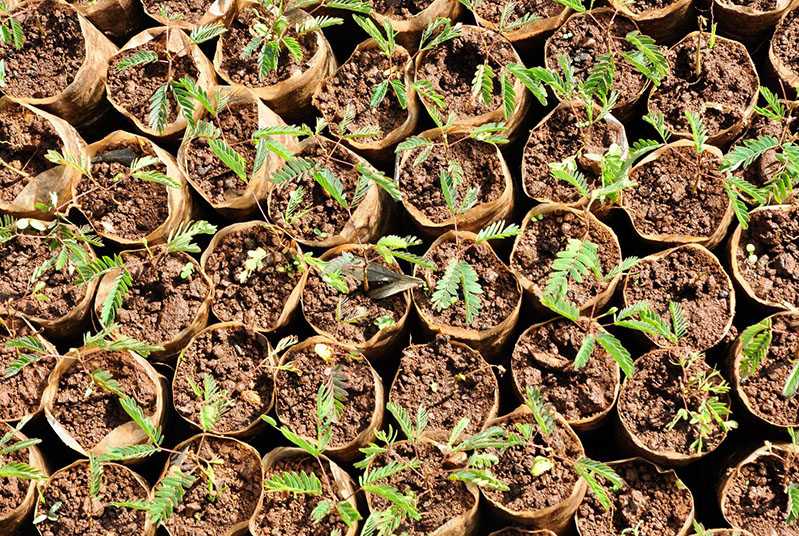Publications

Forgotten food crops in sub-Saharan Africa for healthy diets in a changing climate

From Reach to Transformation: Leveraging the RBET Framework to Secure Women’s Land and Resource Rights

Guidelines for assessing and developing the tree seed and seedling sector

The success of a national agroforestry policy in India has become a model for other countries

The enduring world forest carbon sink

The Global Biodiversity Standard: Manual for assessment and best practices

Refining greenhouse gas emission factors for Indonesian peatlands and mangroves to meet ambitious climate targets

Wildlife and people in the Rupununi: A comprehensive assessment based on science and local knowledge

CIFOR-ICRAF in Kenya: An evolving collaboration
News

Explainer: How trees help protect us from flooding

Call to conservation community: Stop using 80% figure to quantify biodiversity in Indigenous People’s territories

Stepping up for a haze-free Southeast Asia

How Latin America can lead on climate, biodiversity & the circular economy

Renewable energy from charcoal: A response to the challenge

Mining in the Congo rainforest causes more deforestation than previously assumed

Tigers, crocodiles, rising tides: Fieldwork in the largest mangrove forest on Earth

As cocoa prices soar, why are the benefits so unbalanced?

Five key takeaways from UNCBD COP16 in Cali, Colombia
Features

Impact report 2023: Altering course

Trees: Green heroes of the triple crisis

Capturing carbon markets

Blue carbon: Why we’re counting on coastal ecosystems

Restoring Africa’s landscapes: All eyes on African regreening initiatives

It starts with seeds: Seeding diverse, productive ecosystems and economies
Analysis

The true failure of global environmental protection: When national interests trump collective action

Learning outside the classroom: Closer perspectives on gender and development research

A forest is so much more than just its trees

Investing in soils can put countries on a path to land degradation neutrality

From promise to reality: The uneven impacts of REDD+

Community forest stewards: Managers, not labourers

Innovation in forestry: Where it’s happening, why it matters

A year of hope and hardship for the world’s forests

Sustainable development goals hinge on tapping women’s full potential
In the media

More women are thriving in science – does that mean attitudes have changed?

Smallholders offer mixed reactions to calls for delay in EU deforestation law

How scientists debunked one of conservation’s most influential statistics

Study: REDD+ doesn’t work without Indigenous Peoples, but fails to engage them

Almost 20 years after the tsunami, Andaman’s mangroves are still changing

The future of forest carbon credits and voluntary markets
Videos

Regreening Africa a flagship for the UN Decade on Ecosystem Restoration

How it works: CIFOR-ICRAF’s tree seed lab

Trees: Nature’s champions of resilience and regeneration

Spatial data for effective tree planting and land restoration

Science and forestry policy: Bridging the gap

Éliane Ubalijoro – Key highlights from CIFOR-ICRAF at #COP16Riyadh

Daniel Murdiyarso on harnessing coastal wetland ecosystem services beyond carbon

Highlights from UNCBD COP16: The role, challenges, and solutions surrounding trade and biodiversity

Agroforestry in Timor Leste
Events

Holding back the desert: CIFOR-ICRAF at UNCCD COP16

Trees, forests & climate: CIFOR-ICRAF at COP29

Backing biodiversity: Financing forests & trees – CIFOR-ICRAF at UNCBD COP16

Forests & people: CIFOR-ICRAF at IUFRO 2024

Hamburg Sustainability Conference

What is the state of Central African Forests?

Sixth session of the United Nations Environment Assembly (UNEA-6)

GLF Africa 2024 Hybrid Conference: Greening the African Horizon

GLF Peatlands 2024 Hybrid Conference: The climate solution we forgot
In Depth

New Centre of Excellence promotes environmental conservation and climate-smart action in Eastern and Southern Africa
Based in Nairobi, the Regional Centre of Excellence for Biodiversity, Forests, and Seascape Ecosystems Management in Eastern and Southern Africa eeks to offer critical information on the status of the region’s forests, grasslands and aquatic ecosystems, as well as its rich biodiversity.
Read more
South Sumatran villagers opt for the riches of mangrove restoration
The Sungsang Mangrove Restoration and Ecotourism (SMART) project is a Participatory Action Research based venture implemented by CIFOR-ICRAF in partnership with the Temasek Foundation, alongside Sriwijaya University and the South Sumatra Watershed Forum that aims to help build viable local businesses while protecting and restoring forests.
Read more
Guyanese conservation hero Leroy Ignacio wins ‘Green Oscar’
A local wildlife expert and Indigenous Makushi man accompanied scientists on a research trip to confirm songbird species’ presence within the biome, benefitting the region’s communities and ecosystems. In May he received the prestigious international Whitley Award – in the shape of a ‘Green Oscar’.
Read more
A journey across the world’s largest rainforests
As part of our coverage of the 26th IUFRO World Congress, this In Depth story takes you on a journey across the world’s three largest rainforests to explore what they mean for people and the planet; their state; and how they can be sustainably managed for present and future generations.
Read more
Proof of concept: The landscape approach yields results in DRC
What started 17 years ago as a capacity-strengthening project has evolved into an intricate web of activities co-designed with local communities to develop sustainable forest- and tree-based bioeconomies. The Yangambi Engagement Landscape is demonstrating what it takes to achieve landscape-level impact.
Read more
Rattan rising
Indonesia is the world’s largest rattan producer, accounting for 70 percent of total recorded production and home to more than 300 species, although only a handful have commercial value. How should the country manage its burgeoning domestic rattan trade for livelihoods and forests?
Read moreSocial media

Indigenous Peoples’ Day

CRISPR Class II graduation

The Blue Carbon Deck

16 sustainable forestry terms you should know

Forest Policy and Economics: A companion journal to Forest Ecology and Management

Benefits of Agroecology

Carbon markets

Regreening Africa

Celebrating World Soil Day
Initiatives

2024 CIFOR-ICRAF photo competition: Biodiversity, Climate, Restoration

Right Tree in the Right Place – Seed (RTRP-Seed) initiative

Transformative Partnership Platform for Tree Seed and Seedling Delivery Systems (Seed TPP)

Transformative Partnership Platform on Sustainable Use of Wild Species (SU-TPP)

Transformative Partnership Platform on Agroecology

FACT Dialogue

Nature-based solutions for the Amazon

Managalas Component of the EU Forestry-Climate Change-Biodiversity Programme




















